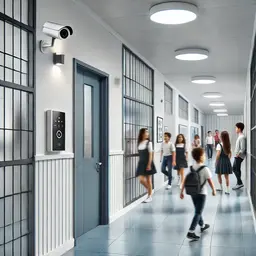
Educational institutions, from elementary schools to large university campuses, are entrusted with the safety and security of students, staff, and valuable resources. In an age where security challenges are increasing, the role of intrusion detection systems (IDS) has become critical in maintaining a secure learning environment. These systems go beyond traditional security measures, providing proactive solutions to deter, detect, and respond to unauthorized access. This article explores the importance of intrusion detection systems in schools and educational facilities, their key benefits, and how they enhance overall campus safety.
What Are Intrusion Detection Systems (IDS)?
Intrusion Detection Systems are advanced security solutions designed to detect unauthorized access or breaches in a facility. These systems use sensors, cameras, and software to monitor doors, windows, and perimeters, providing alerts when suspicious activity occurs. IDS can be standalone systems or integrated with other security measures, such as surveillance cameras and access control systems, to provide a comprehensive security solution.
Why Are Intrusion Detection Systems Critical for Schools?
- Protecting Students and Staff
The primary responsibility of any educational institution is to ensure the safety of its occupants. IDS systems help detect and prevent unauthorized access to school premises, minimizing the risk of potential threats, including theft, vandalism, or physical harm. - Securing Valuable Assets
Schools house valuable resources, such as computers, lab equipment, and sports gear. Intrusion detection systems protect these assets by monitoring critical areas like classrooms, libraries, and storage rooms. This reduces the risk of theft and damage, saving the institution from costly replacements. - Preventing Vandalism
School campuses are often targets for vandalism, especially after hours. IDS systems, combined with surveillance cameras, can deter and detect such activities, ensuring the integrity of the school’s property and reputation. - Enhancing Emergency Preparedness
In emergency situations, such as unauthorized intrusions or break-ins, intrusion detection systems provide real-time alerts to security personnel and law enforcement. This ensures a faster response, reducing the potential for harm. - Compliance with Security Regulations
Many educational facilities are required to comply with local, state, or federal security regulations. Implementing IDS systems helps schools meet these standards while demonstrating a commitment to student and staff safety.
Key Features of Effective Intrusion Detection Systems for Schools
- Perimeter Monitoring
Perimeter sensors detect unauthorized access to the school’s boundaries, such as fences or gates. This is particularly useful for large campuses or schools with open layouts. - Door and Window Sensors
These sensors monitor entry points and trigger alarms if doors or windows are opened without authorization, ensuring that only designated personnel can access secure areas. - Motion Detection
Motion sensors identify suspicious movements within school buildings or on campus grounds, especially during off-hours. - Integration with Surveillance Cameras
IDS systems can be integrated with video surveillance to provide visual verification of alarms, reducing false positives and improving response accuracy. - Real-Time Alerts
Intrusion detection systems send instant alerts to security teams, administrators, or law enforcement through mobile apps, emails, or central monitoring systems. - Access Control Integration
Integrated systems can restrict access to certain areas of the school, such as labs or administrative offices, ensuring that only authorized individuals can enter. - 24/7 Monitoring
Advanced IDS solutions offer around-the-clock monitoring, ensuring the school is protected at all times, even during holidays or after-school hours.
Benefits of Intrusion Detection Systems in Educational Facilities
- Proactive Threat Prevention
By detecting potential breaches before they escalate, IDS systems help schools address threats proactively, rather than reacting after an incident has occurred. - Peace of Mind for Stakeholders
The presence of a reliable IDS reassures parents, students, and staff that the institution takes their safety seriously, fostering trust and confidence. - Cost Savings
Preventing theft, vandalism, or property damage saves schools from costly repairs and replacements. Additionally, IDS systems can reduce insurance premiums by demonstrating enhanced security measures. - Data-Driven Security Improvements
Modern IDS systems provide data and analytics on security breaches and patterns, allowing schools to identify vulnerabilities and make informed improvements to their security strategies. - Scalable Security Solutions
Intrusion detection systems can be scaled to meet the needs of any educational institution, whether it’s a small school or a sprawling university campus.
Challenges in Implementing IDS in Schools
- Budget Constraints
Many schools operate under tight budgets, making it challenging to invest in advanced IDS solutions. However, the long-term benefits often outweigh the initial costs. - Integration with Existing Systems
Integrating IDS with older security systems can be complex, requiring expertise and resources to ensure compatibility and functionality. - Training for Staff
School staff and security teams need proper training to operate and respond to IDS alerts effectively. Regular drills and workshops can help address this challenge. - Minimizing False Alarms
False alarms can disrupt school operations and create unnecessary panic. Regular maintenance and the use of AI-driven analytics can help reduce false positives.
Best Practices for Implementing Intrusion Detection Systems in Schools
- Conduct a Security Assessment
Evaluate the school’s vulnerabilities and identify high-risk areas that require enhanced monitoring. - Choose the Right System
Select an IDS that meets the specific needs of the school, considering factors like size, location, and budget. - Integrate with Other Security Measures
Combine IDS with video surveillance, access control, and fire safety systems for a comprehensive security solution. - Train Staff and Students
Educate staff and students on security protocols, including how to respond to IDS alerts and alarms. - Maintain and Test Systems Regularly
Schedule routine maintenance and testing to ensure the IDS remains operational and effective. - Partner with Experienced Providers
Work with trusted security vendors to design, install, and maintain intrusion detection systems tailored to the school’s needs.
The Future of Intrusion Detection Systems in Education
As technology advances, intrusion detection systems are becoming smarter and more efficient. Here are some emerging trends:
- AI-Powered Detection
Artificial intelligence is enhancing IDS capabilities, enabling systems to differentiate between genuine threats and false alarms. - IoT Integration
IoT devices, such as smart locks and connected cameras, are being integrated with IDS to create more comprehensive security networks. - Cloud-Based Monitoring
Cloud platforms allow for remote monitoring and management of IDS systems, giving administrators greater flexibility and control. - Mobile Accessibility
Mobile apps provide real-time alerts and system control, enabling security teams to respond faster to potential threats.
Conclusion
Intrusion detection systems are essential for maintaining a safe and secure environment in schools and educational facilities. By preventing unauthorized access, protecting valuable assets, and fostering trust among stakeholders, these systems contribute to the overall safety and success of educational institutions. As technology continues to evolve, IDS solutions will become even more effective, offering smarter, more proactive security measures.
Ready to enhance your school’s security? Contact us today to learn more about tailored intrusion detection systems for educational facilities.


